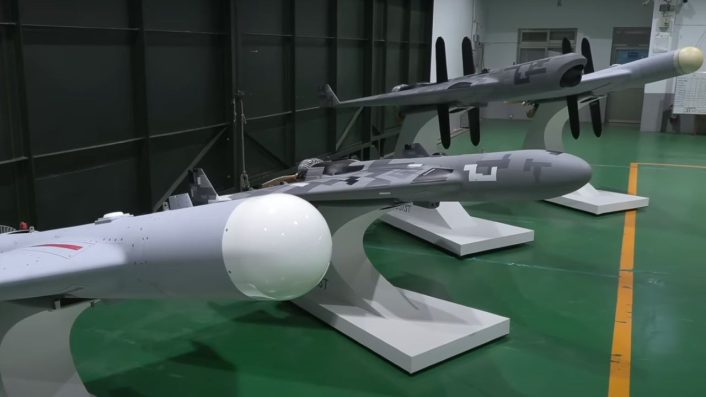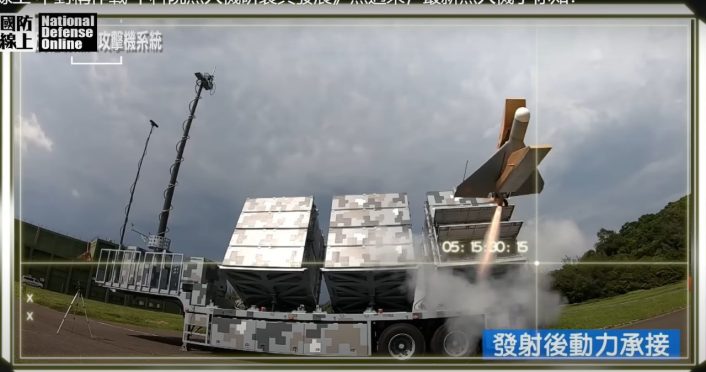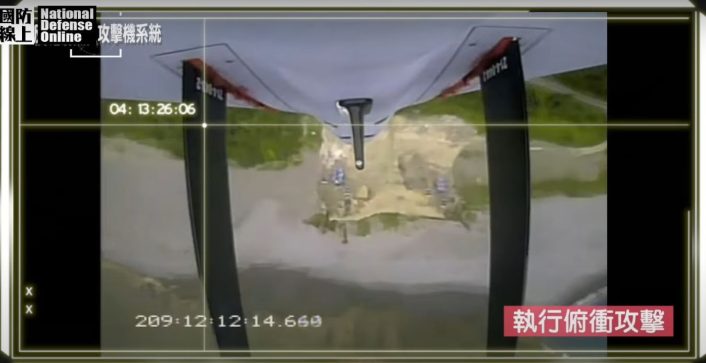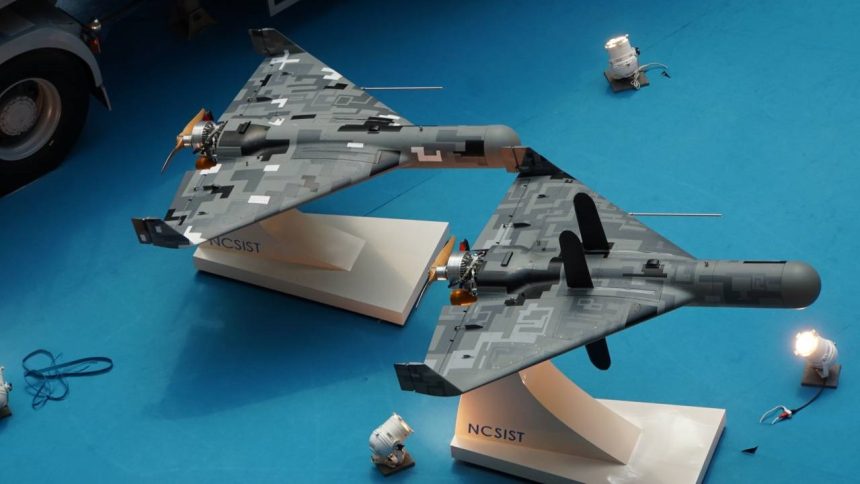The delta-wing, push-propeller kamikaze drone primarily comes in a radar-killing and decoy variant, giving Taiwan new capabilities against Chinese radars.
Taiwan’s Chien Hsiang loitering munition (also referred to as “kamikaze drone”) will be employed for the first time in a massive annual “precision live-fire exercise” held around Jiupeng Base in Pingtung from Aug. 20, 2024 to Aug. 22. Focus Taiwan reported that the drill will also feature the indigenous Hsiung Feng-II (HF-2) and Hsiung Feng-III (HF-3) anti-ship missiles, the Tien-Kung III (Sky Bow III) SAM (Surface-to-Air Missile), as well as the US-made Patriot PAC-2 SAM.
Posts on X said this is the first time the drone would be used in an exercise. The Chien Hsiang also figured in an Aug. 2023 promotional video by the MNA (Military News Agency) that also showed other Taiwanese drone systems. Unveiled in 2019 at the Aerospace and Defense Technology Exhibition in Taipei, the Chien Hsiang bears similarities with the Israeli IAI Harpy loitering munition.
Taiwan News said in Nov. 2022 that the munition, of which 104 units will be produced by 2025, comes in two variants: an anti-radiation weapon and a ‘decoy’. The report further adds that the former is designed to engage enemy missile positions and radar stations, while the latter is meant to activate and lure enemy radar.
The drill meanwhile, called the ‘Sea and Air Precision Ammunition Shooting Exercise,” according to CNA, will also see the RoC Navy and Air Force firing other “confidential ammunition.”

Chien Hsiang loitering munition
The loitering munition has a reported range of 1,000 km, with a speed between 500 and 600 km/h and an endurance of five hours. The delta-wing drone is powered by a pusher propeller piston engine. The Chien Hsiang “can effectively suppress [PLA’s] various radar systems along the coast, inland or at sea,” reports added.
The Aug. 2023 video showcasing Taiwan’s domestic drone development efforts also showed the drone in two more variants, bringing the total variants to four. These comprised units with and without electro-optical turrets, possibly sensors like RF (Radio Frequency) for SEAD/DEAD (Suppression/Destruction of Enemy Air Defense) roles and different nose sections.
“The Russia-Ukraine war showed the multi-faceted use of drones on the battlefield, and also fully demonstrated the mastery of asymmetric warfare,” said an automated translation of the description. The video suggests the radar-baiting and killing Chien Hsiang variants do not need remote human control and are capable of autonomous preset waypoint navigation.
The Chien Hsiang is launched from a 12-cell rectangular trailer-mounted launcher, from which is ejected with a rocket booster. Two pairs of antennas fold out from top and below the drone. The drone also has cameras fitted under the fuselage, but their purpose is not yet known. One of the feeds showing the drone diving down on a land target is recorded from this camera.

Variants and how they might work
Upon reaching the general target area, the SEAD/DEAD variant’s seeker can detect electromagnetic emissions from ground radars and begin its attack run. This is possibly after the ‘decoy’ variant is launched in waves to ‘bait’ radars.
The version with the EO turret with a TV/CCD and infrared camera in the nose, shown in the video, can be programmed to attack specific coordinates without the autonomous hunting. This is after overhead reconnaissance has identified targets prior to the attack.
This variant might also have a man-in-the-loop control for dynamic, evolving and time-sensitive tactical scenarios. Naturally, it also serves a primary ISR capability as a reconnaissance-strike loitering drone.
Some close and recent photos of the Taiwanese Chien Hsiang UAV (loitering munitions/suicide drones) nationally developed (end 2019) by NCSIST (National Chung-Shan Institute of Science and Technology) and its mobile launcher platform pic.twitter.com/qBF7uSEyHq
— Jesus Roman (@jesusfroman) May 12, 2021
As for naval use, while such drones are far from being able to sink large warships, they can be used to strike key radars and sensors on the mast. If not blind them, the attacks would significantly curtail their aerial threat detection surveillance capabilities.
This role would be very similar to what the U.S. Marine Corps suggested when using the AH-1Z Viper in a potential “anti-ship role.” Viper pilots can fly “extremely low at notch airspeeds to avoid detection, shoot the most valuable parts of the ship and fly away,” mentioned the report.

Use for Taiwan
As had been reported by The Aviationist, kamikaze drones offer a low-cost, effective precision strike capability for both baiting/decoy and primary attack missions. Their small size also leaves a lower industrial footprint, unlike larger weapons like tanks or aircraft, as they can be quickly built to replenish the stocks.
This is also consistent with Taiwan’s ODC (Overall Defense Concept), which calls for fielding asymmetric systems like thousands of drones, missiles, USVs and EW jammers to harass and stall the PLA in a multi-layered campaign of attrition until help from the West arrives.
Chien Hisang drones spotted in Southern Taiwan. They will participe in annual precision munition firing for the first time this August.
Photo: liberty times and udn.
Anti-radiarion types are currently in service, EO and GPS guidance types are under development. pic.twitter.com/nYJdKw8Olk
— Taepodong (@stoa1984) August 14, 2024
Their manufacturing can be distributed in small units in urban centers which impose a major collateral damage constraint on an attacker like China. Indeed, a large landmass allows for strategic depth to retreat the military and defense industrial infrastructure and keep fending off an invasion on one front.
Taiwan doesn’t have one and the PLA Navy has long begun exercising its aircraft carriers and destroyers on the island’s eastern waters as well. This can perhaps have a diplomatic solution where Washington and allies can undertake manufacturing of these asymmetric Taiwanese systems for better defense industrial resilience.
Upgrading Cardinal ISR drones
Meanwhile, Taiwan’s Audit Department in July found several technical and performance deficiencies with its Cardinal II drones. This includes absence of “target positioning function” and the inability to use “visible light and infrared lenses at the same time.” The RoC Navy’s basic flight training for Cardinal II UAVs also uses drones of other make, with “no practice aircraft for training.”
The Cardinal II, a further development of the Cardinal I, is a small UAV meant for tactical ISR (Intelligence, Surveillance and Reconnaissance) roles and target acquisition missions. Developed by the NCSIST, the portable monoplane-shaped UAV weighs 5.5 kg and can be quickly disassembled and carried in a backpack. It is launched by hand and recovered via a parachute.









